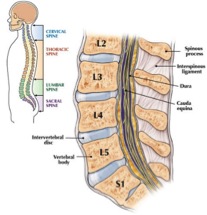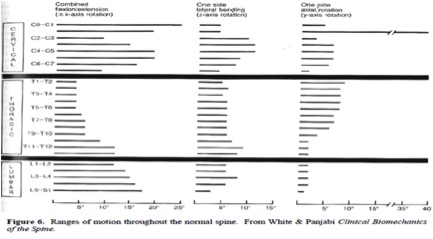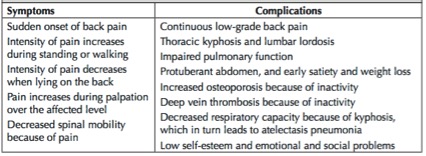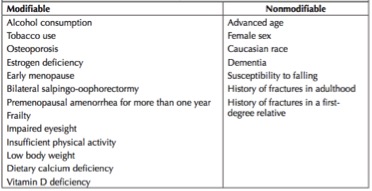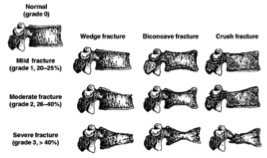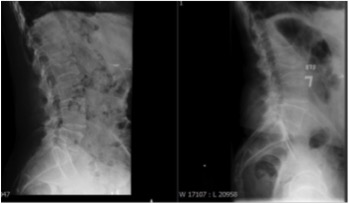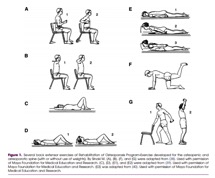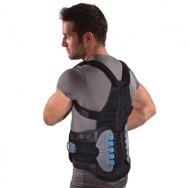Lumbar Compression Fracture
Original Editors - Sam Verhelpen
Top Contributors - Remko De Smedt, Ivakhnov Sergei, Andreas De Feyter, Lucinda hampton, Kim Jackson, Lien Hennebel, Lauren Lopez, 127.0.0.1, Rachael Lowe, Sam Verhelpen, WikiSysop, Alexander Ghyssels, Joshua Samuel and Aminat Abolade
Search Strategy[edit | edit source]
- Databases searched: Pubmed, Web of science, Pedro, Google scholar, Prometheus Atlas
- Keywords: compression, fracture, osteoporotic, lumbar, vertebral, vertebrae
- Combination of keyword: lumbar compression fracture, thoracolumbar compression fracture, vertebral fracture, osteoporotic spine fracture, vertebral compression fracture, osteoporotic compression fracture
Definition/Description[edit | edit source]
The lumbar spine provides stability and support for the whole upper body. Any injury that changes the shape of a lumbar vertebra will alter the lumbar posture, increasing or decreasing the lumbar curve. The definition of a fracture is a complete or partial interruption of the continuity of the bone.[1] Compression fractures are either caused by osteoporosis or trauma. Most of the fractures (60%-75%) occur in the L1 segment, and are often associated with the thoracolumbar region. [2]
The non-traumatic fractures can be caused by osteoporosis (especially in the postmenopausal women), because there is a decrease of the bone mineral density. Those are caused by pressure placed against the vertebrae due to lack of disc cushioning between the spinal bones. To make it easier to define the type of an osteoporosis vertebral compression fracture, a specific classification has been made and can be found in the “Clinical presentation”[3]
Clinically Relevant Anatomy[edit | edit source]
• Anterior Longitudinal ligament
• Posterior longitudinal ligament
• Intervertebral disc
Annulus fibrosus
Nucleus pulposus
• Lumbar vertebrae (L1-L5)
• Cauda equina
• Vertebral endplates
• Dura
The 5 lumbar vertebrae are the strongest and largest of all vertebrae in the spine. This anatomical structure offers them the opportunity to bear the whole upper body. The vertebra starts at the thoracolumbar junction in the beginning of the lumbar lordosis and extend to the promontorium of the sacrum. Those vertebrae are “stacked” together and can provide a movable support structure while also protecting the spinal cord from injury. The lower back region has a greater mobility in flexion and extension. Those segments are also involved in lateroflexion and rotation of the spine, but to a lesser extent.[4] Because of the increased mobility, the lumbar spine is more susceptible to injury. The lumbar disk works as a cushion for the mechanical loads.[5]
Epidemiology /Etiology[edit | edit source]
Most of the time the compression fractures are caused by trauma, osteoporosis, infection and neoplasm.[2][6][7]
As mentioned before, most of the fractures occur at the thoracolumbar junction. This can be explained by looking at the transition zone (T12-L2): the thoracic vertebrae are more rigid in compare to the mobile lumbar region which means that the transition zone receives the biggest load during impacts. The prevalence increases by age. There above at the age of 80 years, 40% of the women have received at least one compression fracture.[2][7]
Postmenopausal middle-aged (55-65) women go through hormonal changes which give them a higher change of developing osteoporosis.[6][8] One-fourth of the postmenopausal women will be affected with vertebral compression fractures.[9][10] The difference in incidence according to sex is nearly double for women, particularly as they age. In general, 10.7 per 1000 women have a vertebral compression fracture annually in the United States, compared with 5.7 fractures per 1000 men.[1]
There are several patient population studies who suggests an increased mortality rate in patients with osteoporosis vertebral compression fractures that correlates with the number of involved vertebrae.[9][10]
In 80% of the situations the vertebral body is invaded by the tumor cells coming from the breast or prostate cancer.[2] This cancer metastasis on the vertebrae, is the most common skeletal complication in vertebral compression fractures.[9]
An existing compression fracture increases the risk to five-times to obtain an other compression fracture in the future. Having 2 or more compression fractures increases the risk by 12 times to get another fracture. [6]
Characteristics/Clinical Presentation[edit | edit source]
Even though these fractures are most common with osteoporosis, there is also a possibility they are caused by high load impact trauma with a flexion compression mechanism.[3][2] A lumbar compression fracture is a serious injury, both when caused by osteoporosis or by trauma. There is a severe risk of neurological damage. When this is the case, surgery is recommended,[9] But the risc to get neurologic deficits is quite uncommon. [2]
The patient will most likely experience pain when the longitudinal ligaments in the spine are damaged. When these structures aren’t damaged, the pain can be overlooked and the compression fracture will be labeled as ‘asymptomatic’. [3] In general is ‘pain’ one of the main symptoms for this pathology. The less common symptoms are described below.[2]
The pathology is also related to some risk factors developing compression fractures over time which are shown below.[2]
There are several typical types of fractures: (Figure 5)
1) Wedge fracture [1][4]
2) Burst/crush fracture [1][4]
3) Biconcave fracture:
→ meaning the walls of the vertebrae stays intact but the center portion is compressed.[5]
In some books the types of vertebral compression fractures are categorised by the applied forces of impact: [6]
- Flexion compression with damage in posterior ligamentous structures.
- Lateral compressions that can be the cause of scoliotic deformation.
- Axial compression causing burst fractures.
In some other resources this pathology is subdivided by the damage in the included endplate. There are four subtypes for compression fractures. [7]
Type A: Both endplates are involved. = Axial load → 16%
Type B: The superior endplate is damaged. = Axial load + flexion → 62%
Type C: Inferior endplate is damaged. = Axial load + flexion → 6%
Type D: Both endplates are intact. = Axial load + rotation → 15%
Each type of (compression) fracture is divided into two groups: Fractures with union and fractures with non-union. It is proven that fractures involving the anterior and middle column, have a higher incidence for non-union than the compression fractures of the anterior column (p< 0.05).[3] Both fractures will be either stable or unstable. It is only for the unstable fractures a surgery is needed, the stable fractures can be treated conservatively. [8]
Patients with osteoporosis vertebral compression fractures might be asymptomatic at the time of diagnosis. Also the age of the fracture is impossible to determine.[10] However, there are several characteristics developing over time:
1) Pain:
• Impact on pain doesn’t depend on the type of fracture.[9]
• Not localized to the side of the compression fracture.
→ Thoracolumbar fractures = lumbosacral/low back pain[10]
• Pain associated with atraumatic activities[10] :
1) Bending forward
2) Vigorous sneezing and coughing
3) standing from being seated,
4) …
2) Risks:
• Patients who had an osteoporosis vertebral compression fracture (20% of the cases):
→ Risk to get a second fracture within a year. [9][10]
→ Decreased pulmonary function[9]
→ Decreased mobility and balance impairment[9]
→ Multiple compression fractures [9][10]
→ loss of height [9],[10]
Test: When the patient’s fingertips can hit the knee or lower thigh during standing, then can we speak about a spinal
shortening.[10]
• A fracture has influence on:
→ Quality of life and disability: can last at least 5 years [9]
→ Pain: 2-4 years [9]
Differential Diagnosis[edit | edit source]
• Coccyx pain: Coccygodynia (Coccydynia, Coccalgia, Tailbone Pain)
• Lumbar facet arthropathy: Lumbar Facet Syndrome
• Mechanical low back pain (Clinical pain presentations)
• Lumbar degenerative disc disease
• Lumbar Spondylolysis and Spondylolisthesis
• Primary Osteoporosis
• Secondary osteoporosis
Diagnostic Procedures[edit | edit source]
A patient’s physical examination might reveal hyper¬kyphosis, or excessive thoracic spine curvature. The finding indicates likelihood of vertebral compression fractures.(Level of evidence: 1A)[10]
It is important to ask the patient about his length. The loss of height that results from a compression fracture may lead to kyphotic deformity of the spine, especially for multiple compression fractures with significant height loss. [1]
The definitive diagnosis of vertebral compression frac¬ture usually is accomplished using a number of medical imaging modalities. Many vertebral compression fractures are identified incidentally on chest radiographs but not addressed by the treating clinician. (Level of evidence: 1A) [10].
1. A Radiograph provides the following diagnostic information. [1][1]:
• Identification of a vertebral compression fracture, including type (wedge, biconcave, or crush). In cases of complete
compression fractures there is a reduction in both posterior and anterior height. [2]
• Measurement of a vertebra’s height loss; a mini¬mum of 20% must be lost compared with normal portions of the vertebral
body for a vertebral compression fracture to be diagnosed. [1][1]
• Measurement of increased distance between the processes or pedicles, indicating vertebral disruprution. [1][1]
• Estimation of how much a vertebra has moved out of alignment along its anterior and posterior lines can be seen on erect
projections.[1][1]
The most widely available and cost-effective initial imaging study is a lateral X-ray of the thoracic or lumbar spine (Figure 6).[1] Comparison topre-existing spine X-rays allows the clinician to diagnose and judge the age of the vertebral fracture. In patients without prior spinal imaging, certain radiographic criteria may aid in diagnosis. A plain radiograph may be all that is necessary for a majority of compression fractures, especially if one proceeds with conservative, medical management.
2. When there is need for further characterization, 'a compute 'tomography (CT) scan allows for the best imaging of bony anatomy and improved assessment of loss of height, fragment retropulsion, and canal compromise. [1]
3. However, magnetic resonance imaging (MRI) is the best study for judging fracture age, as it will show bony edema (T2) for an
acute fracture, allows for the evaluation of neural compromise secondary to compression and will also reveal integrity of the
spinal ligamentous complex, which can be important during surgical evaluation of fracture stability. (Level of evidence: 2B) [1]
4. However Samah Al-Helo proposes a fully automated Computer-Aided Diagnosis System (CAD) for the diagnosis of vertebra wedge/compression fracture from CT images that integrates within the clinical routine that consist of a set of clinically motivated features that distinguish the fractured vertebra. (Level of evidence: 4)[3]
Without a history of trauma, spontaneous vertebral compression fractures are typically pathognomonic for osteoporosis. After the diagnosis of a compression fracture on initial imaging, bone density should be assessed by DEXA scan. Roughly half of patients with vertebral fractures have osteoporosis (T score , −2.5) and another 40% have osteopenia (T score −1 to −2.5). [4]
Outcome Measures[edit | edit source]
According to Lavelle EA, Cheney and Lavelle WF the American Society of Anesthesiologists Physical Status score (ASA) is a predictive outcome measure of mortality in a surgical population of vertebral compression fractures. (Level of evidence: 3B)[5]
R. Buchbinder et al. used the following outcome measures to evaluate the progression of a patiënt who suffers from an osteoporotic vertebral fracture: (Level of evidence: 2B)[6]
• Pain: Visual analogue scale for overall pain (VAS).
We can use this scale for measuring pain at night, rest, daily activities,…
• Quality of Life: this can be measured with the use of the Quality of Life Questionnaire of the European Foundation for
osteoporosis (QUALEFFO). Another possibility is to use the Assessment of Quality of Life (AQoL) questionnaire or the
European Quality of Life–5 Dimensions (EQ–5D) scale.
• Physical functioning: measured bij a modified 23-item version of the Roland–Morris Disability Questionnaire.
Other validated questionnaires are the:
• The Patient-Specific Functional Scale (PSFS): This useful questionnaire can be used to quantify activity limitation and
measure functional outcome for patients with any orthopaedic condition. The PSFS is a valid, reliable, and responsive
outcome measure for patients with upper extremity problems. [7]
• Quebec Back Pain Disability Questionnaire: measures the way in which the patients back-pain influences his activities of
daily living by using a 20-item 6-scale questionnaire. These outcomes score within the range of 0 and 100, determines the
level of functional disability, with higher numbers representing greater levels of disability. The construct validity of the
English, French and Dutch version is good.[8]
Examination[edit | edit source]
It is important to know that there are no fully validated screenings for diagnosing lumbar compression fractures. Therefore radiologists have an important role in diagnosing spinal fractures. (described in ‘diagnostic procedures’)
Input from radiologists is needed because there is a lack in knowledge for diagnosing those fractures without images and thereabove the symptoms might be absent or it is difficult to determine the cause of the complaints. (Level of Evidence: 2A)[2]
The general aspects needs to be taken in consideration when performing the clinical examination:
1. Structured anamnesis:
• Basics questions
• More attention to:
Any notable event the patient experienced in the history, causing the symptoms and complaints?
→ List of symptoms and risk factors can be find in ‘5.Characteristics/Clinical presentation’
→ High-Risk Mechanism of injury (Level of Evidence: 2A):[2]
• Accident with a vehicle with a higher speed than 70 kph
• Fall from 3m or higher
• Ejection from a vehicle seat
•…
• Red Flags in Spinal Conditions !!
2. Inspection:
Look at:
1. Sagittal convexity (Level of Evidence: 1A)[10][10]
• Thoracic kyphosis
• Lumbar Lordosis
• Dowager’s hump (indication for osteoporosis)
2. Swelling or hypertonic muscles
3. Posture
4. Antalgic stand
Acute phase: Localised tenderness over the involved level is a known characteristic for acute fracture. However, this does not distinguish whether the anterior or posterior column is involved. [10]
Changes in the size of the thoracic kyphosis/lumbar lordosis: [10][9]
• Can lead to a reduction of the abdominal space and/or a decreased ventilator capacity.[9]
• Can lead to multiple anterior wedge fractures: increased thoracic convexity[10]
• Can lead to an increased thoracic kyphosis with missing prevalent fracture of the vertebrae in older adults.[10]
3. Testing:
• Active ROM
→ will be restricted with most acute fractures (flexion/extension/retroflexion/rotation) (Level of Evidence: 2C)[9]
• Gait
• Provoking movements like: [10]
1. Flexion/extension
2. Rotation
3. Retroflexion
4. Sneezing/ coughing
4. Some specific clinical signs in physical examination:
1. Patient is standing in the front of a mirror with the examiner behind him. That way the therapist can gauge their reaction.
Using firm, closed-fist percussion the spine will be examined over the entire length. (Level of Evidence: 2C)[10]
⇒ Positive test: Patient is complaining about sharp, sudden, fracture pain.[10]
Sensitivity: 87,5 %
Specificity: 90 %
2. The patient is gently asked to take place on the examination couch and lie supine, using only one pillow.
(Level of Evidence: 2C)[10]
⇒ Positive test: Patient is unable to lie supine, because the severe pain is the limitation factor. [10]
Sensitivity: 81,25 %
Specificity: 93,33 %
3. Physical examination reveals:
• Tenderness when palpating or directly percussion over the area of the fracture. (Level of Evidence: 4)[1]
• Spasm in paraspinal muscles. (Level of Evidence: 4)[1]
= mostly in acute phase [10]
4. Osteoporotic patients might have a loss of height. We look at the fingertips.
⇒ Positive test: When the patient’s fingertips hit the knee or lower thigh during standing, then can we speak about a spinal
shortening [10]
Note: Signs 1 and 2 are useful adjuncts in evaluation symptomatic osteoporotic vertebral compression fractures and are reliable indicators of the presence of a fracture. When the test is positive there is reason to rationalise and refer the patient for a MR scan. (Level of Evidence: 2C)[10]
Medical Management
[edit | edit source]
There are several medical management methods to treat a lumbar compression fracture.
Before anything else you need to control the pain:
Acute pain control may include: (Level of Evidence: 2B) [1]
• nonsteroidal anti-inflammatory drugs (NSAIDs)
• muscle relaxants
• narcotic pain medication
• neuropathic pain agents (ie, tricyclic antidepressants)
• local analgesic patch
• intercostal nerve blocks, and transcutaneous nerve stimulation units.
NSAIDs are often first-line drugs for back pain as they do not have sedating effects. However, they do have gastric toxicity and an increased risk of cardiac events for patients with hypertension and coronary artery disease (Level of Evidence: 2C) [3]
Opioids and muscle relaxants may provide strong relief when NSAIDs are inadequate but have significant sedative effects as well as the risk of dependency. As such their use needs to be carefully balanced in the geriatric patient. (Level of Evidence: 2C) [4]
Preventative medicine(Level of Evidence: 2B)[1]
Other than acute pain control, medical therapy should be aimed at improving bone quality and thus reducing the risk of future fracture. Agents for treating osteoporosis include:
• bisphosphonates
• selective estrogen receptor modulators
• recombinant parathyroid hormone
• calcitonin
• vitamin D
These agents act through either antiresorptive or osteogenic mechanisms. The bisphosphonate alendronate is a first-line medication given its favorable safety profile and efficacy in reducing fracture risk. Hormone replacement therapy may be an option for younger postmenopausal women. Finally, while calcium and vitamin D are insufficient alone in reducing fracture risk, supplementation may be necessary for deficient patients. Interestingly, several medications for osteoporosis treatment also play a role in acute pain relief. Calcitonin has been found in multiple randomized controlled trials to provide pain relief for acute compression fractures
Surgical management
A surgical management is required when neurological deficits, instability, prevention of kyphosis and pain occurs caused by the lumbar fracture. Also when several nonoperative treatments didn’t help, surgery is recommended. In most patients kyphoplasty and vertebroplasty are good options.(Level of Evidence: 2A) [9] Vertebroplasty involves the percutaneous injection of bone cement into the affected vertebra to stabilize the fractured vertebral body, and results in immediate pain relief. Kyphoplasty is a type of vertebroplasty in which inflatable bone tamps are used to restore vertebral height. After removing the balloons, the resulting intravertebral cavity is filled with bone cement to stabilize the vertebral body. (Level of Evidence: 1A) [4]
Several studies have demonstrated that both, kyphoplasty and vertebroplasty, results in immediate and sustained pain relief in most patients. (Level of Evidence: 2A) [9] McGirt et al published a review in 2009 of all studies of vertebral augmentation outcomes over a 20-year period. The authors found level I evidence that vertebroplasty provides superior pain control over medical management in the first 2 weeks, and level II–III evidence that within the first 3 months there are superior outcomes in analgesic use, disability, and general health, and finally level II–III evidence that by 2 years there is a similar level of pain control and physical function. With regards to kyphoplasty, there was level II–III evidence of improvement in daily activity, physical function, and pain control at 6 months, compared to medical management. (Level of Evidence: 2A)[5]
Non medical management
[edit | edit source]
Non-operative treatment consists of: (Level of Evidence: 2B)[6]
• Pain relief (NSAIDs,muscle relaxants,narcotic pain medication →see medical management)
• Orthesis
• Rehabilitation program
Non-operative treatment goals: (Level of Evidence: 2A)[7]
• Pain control
• Early mobilisation
• Prevention of deformity
• Functional Restoration
Physical Therapy Management
[edit | edit source]
After this, education in activities of daily living and mobility in ways to avoid pain is essential for this impaired patiënt population that is often elderly. (Level of Evidence: 2C) [7] It is important that the patient overcomes his fear of movement (kinesiophobia) and continues with his/her activities. Rest is not recommended, it’s important that the patient remains active. (Level of Evidence: 1B) [8]
Supervised physical therapy:
- Postural taping: from anterior aspect of each shoulder, posteriorly and obliquely down to opposite rib cage(Level of Evidence: 1B)[10]
- Soft tissue massage: performed in prone to erector spinae, rhomboids, upper trapezius -stroking, circular frictions and petrissage (Level of Evidence: 1B) [10]
- Strengthening-exercises: It is important to improve the lumbar stabilization by strengthening the muscles of the lower back, strengthening the patient’s supportive axial musculature (in particular the spinal extensors) but also the muscles of the trunk. Exercises should focus on strengthening back extension and may include weighted or unweighted prone position extension exercises, isometric contraction of the paraspinal muscles, and careful loading of the upper extremities. (Level of Evidence: 2B) [1],[1]
- Physiotherapy program with manual techniques, clinician-led exercises, and home exercises designed to reduce pain, increase back extensor and lower limb muscle strength, and improve posture, trunk stability and trunk mobility. (Level of Evidence: 1B) [10]
- The Spinal Proprioception Extension Exercise Dynamic (SPEED) program designed by Sinaki9 is an example of a regimen that focuses on strengthening the spinal extensors using a weighted kypho-orthosis and postural and proprioceptive training, through twice-daily, 20-minute exercise sessions. (Level of Evidence: 2C) [2]
- Strengthening of abdominal, gluteal and hip muscles is important to support spinal structures with noncompressive forces and can be done for integrating the exercises into a more functional rehabilitation programme. Functional exercises that use all planes of motion and stimulate activities of daily living may be more beneficial for the patiënt. (Level of Evidence: 2C) [7]
Example of exercise program: (Level of Evidence: 1B)[10]
| Exercise | Dosage | Weeks |
| Elbows back in sitting Hands behind head with elbows pointing out to side. Pressing elbows back by performing scapular retraction |
5 sec hold × 5 reps | 1-10 daily |
| Trunk mobility in sitting Hands on shoulders, gentle rotation in both directions and lateral flexion to each side |
5 reps in each direction | 1-10 daily |
| Four point kneeling with transversus abdominus Push into floor with hands, knees and feet then draw navel up and in. Hold 5sec |
8-10 reps × 2 |
3×/week |
| Four point kneeling with one arm and leg lift As above, then lift one arm off ground. Progress to also lifting extended leg off ground at same time |
8-10 reps × 2 | 3-10 3×/week |
| Bridging in supine Knee bent and feet flat on ground. Pushing through feet to lift back and pelvis off ground |
5-10 sec hold × 5 | 1-2 3×/week |
| Hip extension in prone 8-10 reps × 2 3-10 Raising one leg off the ground and then the other |
8-10 reps × 2 | 3-10 3×/week |
| Seated row with dumbbells Upright sitting and pull hands up towards chest by bending elbows and then lowering |
8-10 reps × 2 | 1-10 3×/week |
Patients who followed a back extensor-strengthening extensorprogram (like in the 6th point of the supervised physical therapy) have a smaller chance to relapse into a new lumbar fracture in the future. (Level of Evidence: 2B)[1]
When, during physical therapy session with a non-operative compression fracture patient, it shows that the patient continues to have a lot of pain, or there is no progression at all, it is advised to send the patient to a doctor or preferably an orthopedic surgeon, as surgery may be required. (Level of Evidence: 2A) [9]
Orthotics
[edit | edit source]
The rehabilitation starts with a thoracic-lumbar-sacral orthosis. The physiotherapist learns the patient how to use that orthosis. It is recommended to wear the brace/orthosis for 6 to 12 weeks, followed by supervised physical therapy. (Level of Evidence: 1B)[4]
It is important to highlight that there isn’t really any true evidence on the effectiveness of a brace in the healing of the vertebrae itself, but we can be sure a brace improves the body posture. It increases the trunk muscle strength in patients with osteoporotic fractures in the vertebrae. (Level of Evidence: 1B) [2] The use of a spinal orthosis maintains neutral spinal alignment and limits flexion, thus reducing axial loading on the fractured vertebra. In addition, the brace allows for less fatigue of the paraspinal musculature and muscle spasm relief. (Level of Evidence: 2B)[1]
Fractures in the thoracic spine may be treated with thoracolumbar orthesis. Examples include the Jewitt, cruciform anterior spinal hyperextension, and Taylor brace. Braces which extend to the sacrum are termed thoracolumbar sacral orthoses. Finally, lumbosacral orthoses are also available for lumbar fractures but are only effective in restricting sagittal plane motion in the upper lumbar spine (L1–3). (Level of Evidence: 2B) [1] Intervertebral motion has been shown to actually increase from L4–S1 with a lumbosacral orthoses brace. (Level of Evidence: 1B) [4]
Key Research[edit | edit source]
The following articles are key evidence pieces for physical therapy interventions:
- Ensrud KE, Schousboe JT. Vertebral fractures. N Engl J Med. 2011;364(17):1634-1642. doi:10.1056/NEJMcp1009697. (Level of evidence: 1A) [10]
- Dewar, Cherie. "Diagnosis and treatment of vertebral compression fractures." Radiologic technology 86.3 (2015): 301-323. (Level of evidence: 2A) [5]
- Bennell, Kim L., et al. "Effects of an exercise and manual therapy program on physical impairments, function and quality-of-life in people with osteoporotic vertebral fracture: a randomised, single-blind controlled pilot trial." BMC musculoskeletal disorders 11.1 (2010): 1. (Level of evidence: 1B) [9]
Resources
[edit | edit source]
1) Tucker C. (1990). The mechanics of sport injuries. (edition 2). Wiley & Sons, Incorporated, John
2) Solomon L., Warwick D., Nayagam S., (2010). Apley’s system of orthopaedics and fractures. (edition 9). CRC Press LLC
3) Shultz, Sandra,Houglum, Peggy,Perrin, David.(2010). Examination of musculoskeletal injuries. (edition 3). Human Kinetics Publishers
4) Kenneth J. Koval, Zuckerman J. D., Charles A. Rockwood.(2002). Handbook of fractures. Lippincott Williams & Wilkins
5) Kenneth L. G. Mills, Graham Page, Richard J. P. Siwek.(1990). A Colour atlas of LOW BACK PAIN. F.A. Davis
Internet: http://emedicine.medscape.com
Clinical Bottom Line[edit | edit source]
Lumbar compression fractures, whether from trauma, osteoporosis, infection or neoplasm, occur often enough to be worthy of adequate research with focus on healing procedures. Most of the present information acknowledges that there is no evidence which proves that surgical intervention of a lumbar compression fracture surpasses physical therapy. However, no current research exists that effectively compares the most effective therapy. Current recommendations revolve around prevention, basic core and lumbar muscle strengthening and postural taping. We believe that more research, that focuses specifically on lumbar compression fractures and on the most effective therapy treatments, is necessary.
Recent Related Research (from Pubmed)[edit | edit source]
Guo, Jia-Bao, et al. "Surgical versus non-surgical treatment for vertebral compression fracture with osteopenia: a systematic review and meta-analysis." PloS one 10.5 (2015): e0127145.
Extension:RSS -- Error: Not a valid URL: Feed goes here!!
References[edit | edit source]
- ↑ 1.00 1.01 1.02 1.03 1.04 1.05 1.06 1.07 1.08 1.09 1.10 1.11 1.12 1.13 1.14 1.15 1.16 1.17 1.18 1.19 1.20 1.21 1.22 1.23 1.24 Zdeblick TA. Compression and wedge fractures: treatment and recovery. Spine Univers 2009
- ↑ 2.00 2.01 2.02 2.03 2.04 2.05 2.06 2.07 2.08 2.09 2.10 2.11 2.12 Alexandru, Daniela, and William So. "Evaluation and management of vertebral compression fractures." Permanente Journal 16.4 (2012). (Level of evidence: 2A)
- ↑ 3.0 3.1 3.2 3.3 3.4 3.5 Chieh-Tasai W, et al. Classification of symptomatic osteoporotic compression fractures of the thoracic and lumbar spine. Journal of Clinical Neuroscience 2006; 12: 31-38 (Level of Evidence 1B)
- ↑ 4.0 4.1 4.2 4.3 4.4 4.5 4.6 4.7 Kinematics of the Spine. In White AA, Panjabi MM, eds: Clinical Biomechanics of the Spine, 1990
- ↑ 5.0 5.1 5.2 5.3 5.4 Bogduk N. Clinical anatomy of the lumbar spine and sacrum. Elsevier, 2005
- ↑ 6.0 6.1 6.2 6.3 6.4 6.5 Gertzbein SD, Khoury D, Bullington A, St John TA, Larson AI. Thoracic and lumbar fractures associated with skiing and snowboarding injuries according to the AO comprehensive classi cation. Am J Sports Med 2012 Aug;40(8):1750-4. DOI: http://dx.doi. org/10.1177/0363546512449814 (Level of evidence: 2A)
- ↑ 7.0 7.1 7.2 7.3 7.4 7.5 7.6 Goldstein, Christina L., et al. "Management of the elderly with vertebral compression fractures." Neurosurgery 77 (2015): S33-S45. (Level of evidence: 2A)
- ↑ 8.0 8.1 8.2 8.3 Meunier PJ. Osteoporosis: diagnosis and management. Martin Dunitz, 1998
- ↑ 9.00 9.01 9.02 9.03 9.04 9.05 9.06 9.07 9.08 9.09 9.10 9.11 9.12 9.13 9.14 9.15 9.16 9.17 9.18 Sujoy M, Yu-Po, L. Current concepts in the management of vertebral compression fractures. Oper Tech Orthop 2011; 21:251-260 (Level of Evidence 2A)
- ↑ 10.00 10.01 10.02 10.03 10.04 10.05 10.06 10.07 10.08 10.09 10.10 10.11 10.12 10.13 10.14 10.15 10.16 10.17 10.18 10.19 10.20 10.21 10.22 10.23 10.24 10.25 10.26 10.27 10.28 10.29 Kim DH, Vaccaro AR. Osteoporotic compression fractures of the spine; current options and considerations for treatment. The spine Journal 2006; 6:479-487 (Level of Evidence 1A)
Presentations[edit | edit source]
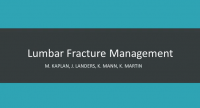 |
Management of Lumbar Fractures
This presentation, created by Mel Kaplan, Jacob Landersm Kari Mann, and Kelsie Martin; Texas State DPT Class. |
